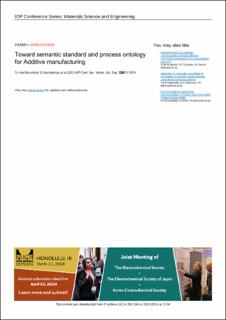| dc.contributor.author | Gouttebroze, Sylvain | |
| dc.contributor.author | Friis, Jesper | |
| dc.contributor.author | Hovig, Even Wilberg | |
| dc.contributor.author | Boivie, Klas Magnus | |
| dc.date.accessioned | 2024-04-17T09:28:04Z | |
| dc.date.available | 2024-04-17T09:28:04Z | |
| dc.date.created | 2023-11-13T15:21:30Z | |
| dc.date.issued | 2023 | |
| dc.identifier.citation | IOP Conference Series: Materials Science and Engineering. 2023, 1281: 012014. | en_US |
| dc.identifier.issn | 1757-8981 | |
| dc.identifier.uri | https://hdl.handle.net/11250/3126967 | |
| dc.description.abstract | Advanced modelling of additive manufacturing often requires the combination of models at multiple scales and multi-physics. Therefore, building the modelling workflow describing the process is complicated. The modelling is also only a part of the innovation process and must be connected to practices, experimental work, and characterisation. Efficient communication and data exchange between the different actors could quickly become a challenge. Recent developments in the frame of the EMMC (European Material Modelling Council) and in the EU project OntoTrans points toward the early integration of semantic description and the creation of dedicated domain ontologies. This require an unambiguous and consistent use of terms and definitions for various concepts within each field of technology, and international standards is an available source for structured technical terms and definitions. For additive manufacturing (AM) the international standard ISO/ASTM 52900 "Additive manufacturing - General principles - Fundamentals and vocabulary" is the internationally recognised source for terms and definitions. Basing the ontology on the AM terminology standard will greatly facilitate integration of AM processes as a part of an industrial manufacturing system. Therefore, the present work attempts to harmonise the standard terminology and the ontology concepts. Then, to improve the impact and connection to material science, the concepts will be connected to a microstructure domain ontology and to the top- and middle-level ontology EMMO. The conceptualisation and application of the ontologies will be illustrated through simple examples of process and material modelling. | en_US |
| dc.language.iso | eng | en_US |
| dc.publisher | IOP Publishing | en_US |
| dc.rights | Navngivelse 4.0 Internasjonal | * |
| dc.rights.uri | http://creativecommons.org/licenses/by/4.0/deed.no | * |
| dc.title | Toward semantic standard and process ontology for Additive manufacturing | en_US |
| dc.title.alternative | Toward semantic standard and process ontology for Additive manufacturing | en_US |
| dc.type | Peer reviewed | en_US |
| dc.type | Journal article | en_US |
| dc.description.version | publishedVersion | en_US |
| dc.rights.holder | Published by IOP Publishing under a CC-BY license. | en_US |
| dc.source.pagenumber | 11 | en_US |
| dc.source.volume | 1281 | en_US |
| dc.source.journal | IOP Conference Series: Materials Science and Engineering | en_US |
| dc.identifier.doi | 10.1088/1757-899X/1281/1/012014 | |
| dc.identifier.cristin | 2196007 | |
| dc.relation.project | Norges forskningsråd: 309584 | en_US |
| dc.relation.project | Norges forskningsråd: 237900 | en_US |
| dc.source.articlenumber | 012014 | en_US |
| cristin.ispublished | true | |
| cristin.fulltext | original | |
| cristin.qualitycode | 1 | |

